
The future of collaboration
The Metaverse is the next evolutionary stage of the internet. It is a virtual world where people come together to work, play and learn.
Design4real is an agency that specializes in the development of tailor-made virtual reality meetings and coworking solutions in the metaverse. We offer our customers the opportunity to design their meetings and working environments according to their own ideas.

Why is social VR better than Zoom or Teams Meetings?
Social VR offers a number of advantages over traditional meetings and training, including:
The representation of the participants by Avatarswhich, depending on the hardware used, are capable of hand movements via Hand tracking and moving the mouth when speaking, the user gets the impression of really being physically present at virtual events. In virtual reality, for example, we can see very precisely whether our conversation partner, i.e. the avatar, is looking at us or is inattentive and looking elsewhere. In addition to the usual presentation tools such as slide presentations and whiteboards, simulated experience spaces can be created in VR. Meetings can take place underwater or on the moon, for example, if that fits the theme. In social VR applications, I find it much easier to start a conversation with still unknown other participants of an event than in a video conference, because the social behavior of the participants is very similar to the real behavior at a networking event.
The participants come together in small groups to have a conversation. I approach with my avatar, listen to what is being said, join in, if I am interested in the conversation and a pause occurs, I introduce myself and am then usually integrated into the conversation. Just like in real life. This is impossible with videoconferencing solutions like Zoom or Teams. How could it be - everyone hears everyone else talking?
If their participants are explorative and open to new things, why not. But don't expect too much.
Social VR is still young and there is still some room for improvement on both the hardware and software side.
Breaks are important: Schedule VR free breaks where the audience can also put the headset down in between.
VR Software Research: Take a close look at the social VR platform of your choice and analyze whether your event concept can be realized with the modalities of the software and hardware.
Calculate the costs: The costs for setting up a VR event differ extremely between the event platforms. For example, an event with 90 participants cost nothing at Altspace VR, while Engage VR charges at least €10,000 for corporate events.
Does the look suit you? Take a look at the graphical look of the chosen VR platform and decide if the look is suitable for your event.
Brief your speakersMake sure that your speakers are part of "the VR show". If their avatars are just standing around on the virtual stage like cardboard cutouts, because the actors didn't feel like doing the show, it's not a good idea. Avatar or simply do not know how to do it, the illusion of the speaker's presence in the audience collapses.
The right VR glasses for their protagonists: Therefore, the speakers should have VR glasses that allow their body language to be transferred to the avatar as vividly as possible. This is actually the case with all glasses that are available via Position tracking have. Cordless so-called 3Dof VR glasses without position tracking like Oculus Go or Pico G2 or the new Pico G3 are the wrong choice for speakers. Goggles like the Meta Quest Pro or the Pico 4 Enterprise feature Facetracking, which also makes it possible to transfer the facial features of the wearer of the VR headset to their avatar.
Capitalize: Many social VR and Metaverse platforms give you the option to show slide presentations in VR. Write all texts that are shown from presentation slides in VR large and legible. Reading small texts with VR goggles is usually a challenge, as many headsets still lack sufficient image sharpness to allow comfortable reading.
Support In reality and in VR: Make sure you have enough staff to attend to your guests in the virtual space. The first time I attended a VR event, I didn't dare say a word at first because I didn't know if everyone in the event would hear me. If support staff explain the rules of the virtual world to guests arriving in the virtual world, your guests will find access much faster. Also, assign people who can provide support via email or chat outside of the VR goggles if their guests have hardware or software problems. Otherwise, you might run the risk that some of your guests won't even make it into the virtual world and will be excluded because they can't get support for your event in the real world.
You should think about the following
Virtual reality (VR) is a technology that allows users to immerse themselves in a virtual world. In recent years, VR has increasingly become a popular form of entertainment. One of the fastest growing areas of VR is social VR.
Social VR platforms allow users to meet and interact with other people in a virtual world. These platforms offer a variety of ways to connect with other people, including:
Social VR platforms offer a number of advantages over traditional online communication platforms. In a virtual world, users can meet and interact in a way that would not be possible in the real world. This can lead to a more intense and personal experience.
What social VR platforms are there?

Mesh uses HoloLens 2 to provide users with an immersive experience that feels like they are in the same room. Users can see each other, interact with each other and even work together on projects.
◉ Cross-device use
◉ Promoting cooperation
◉ Scalable platform
◉ Interactive hands-on demos
◉ Security and data protection

Spatial VR is more than just a meeting platform; it is a space where creativity and collaboration merge in a unique way. With photorealistic avatars and the ability to manipulate 3D objects, Spatial VR brings teams from all over the world together as if they were in the same room. It's ideal for brainstorming sessions, project presentations and more.
◉ Very elegant UI
◉ Ready Play Me avatars
◉ Sophisticated presentation tools, whiteboards, sticky notes
◉ Exchange documents possible
◉ Integration of video streams
◉ Custom 3D model upload
◉ Unfortunately not suitable for large events
Compatible with Meta Quest 2 and 3, HoloLens 2, Magic Leap 2

◉ Virtual desktop in VR
◉ Screensharing and Chat
◉ Compatible with Meta Quest, Rift, Go, Vive
◉ Support for 2D on PC

◉ Up to 50 remote users possible
◉ Media streaming
◉ Playback of recorded VR sessions
◉ Graphically detailed
Compatible: Oculus Quest, Rift, Pico, Vive, Tablet
◉ Support for 2D on PC

◉ 70+ remote users possible in one room
◉ Media streaming
◉ Graphically kept rather simple
◉ Avatars with comic look
◉ Good built-in networking tools
◉ None different
Environments one is always on the island
◉ No customizing
Compatible with Oculus Rift, Quest, Vive,
◉ Support for 2D on PC


◉ Media streaming support
◉ Graphically kept simple
◉ Avatars chaotic full of memes
◉ Good built-in networking tools
◉ Good customizing
◉ Great community support
◉ Minigames
◉ Compatible with Oculus Rift, Oculus Quest, Vive,
◉ Support for 2D on PC

| Platform | Description | Features | Costs | PC | VR | Mobile |
|---|---|---|---|---|---|---|
| Spatial | Virtual office and meeting tool | 3D meetings, collaboration, whiteboard, video conferencing | Free for up to 10 people, from 10 people 10 US dollars per person per month | Yes | Yes | No |
| Engage VR | Social VR platform for companies | Meetings, events, training, gamification | Free for up to 10 people, from 10 people 10 US dollars per person per month | Yes | Yes | No |
| Somnium Space | Virtual world with sandbox functions | Create your own worlds, avatars, items | Free of charge, premium membership from 10 US dollars per month | Yes | Yes | No |
| Vroom | Virtual world for gaming and entertainment | Multiplayer games, concerts, events | Free of charge, premium membership from 5 US dollars per month | Yes | Yes | No |
| VR Chat | Virtual world with a large community | Chat, play, create your own worlds | Free of charge | Yes | Yes | No |
| Virbela | Virtual world for companies and organizations | Meetings, events, training courses | Free for up to 10 people, from 10 people 15 US dollars per person per month | Yes | Yes | No |
| Horizon Worlds | Virtual world of Meta | Chat, play, create your own worlds | Free of charge | Yes | Yes | No |
| Mozilla Hubs | Open source social VR platform | Meetings, events, collaboration | Free of charge | Yes | Yes | Yes |
| Rec Room | Virtual world for gaming and entertainment | Multiplayer games, mini-games, events | Free of charge, premium membership from 4.99 US dollars per month | Yes | Yes | Yes |




